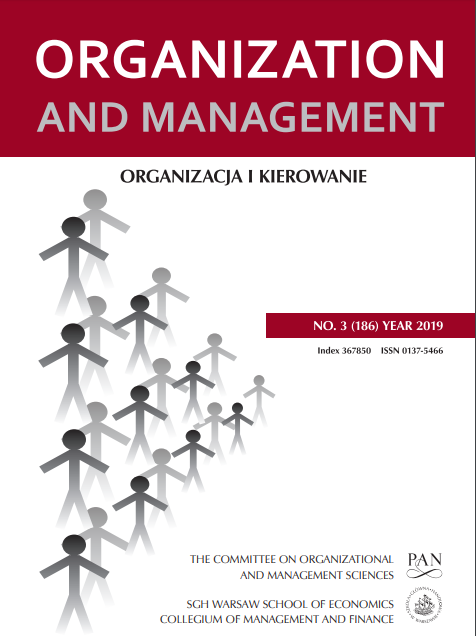Technological Maturity As An Imitation Strategy Basis – Recognition Among Manufacturers Of The Agricultural Machinery Sector
Main Article Content
Abstract
The fundamental objective of this publication is to assess the level of technological maturity that implies the implementation of an imitation strategy. The studies were carried out among manufacturers operating in the agricultural machinery sector. In reference to such an outlined purpose, as a necessary activity, it was recommended: at the theoretical level – using the methods of reconstruction and literature interpretation – to nominate the questions giving opinions on the technological maturity level in the sphere of the effective imitation strategy implementation; at the design level – to compile a research tool in the form of an assessment sheet resulting from the literature exploration and assessment among deliberately chosen experts; and at the empirical level – to recognize the technological maturity level among manufacturers of the agricultural machinery sector (self-assessment). In order to carry out the studies, the authors use a method of literature studies, expertise, a creative discussion, participant observation as well as providing opinions with the use of a self-assessment questionnaire. It seems that the complexity of problems and small, so far, scientific recognition justify treating these issues as the research subject. Additional confirmation of the need to undertake research also results from the fact that on the publishing market there is a shortage of scientific studies on the organization maturity, especially, in relation to – used by machinery construction companies – technologies.
Article Details
References
Ties that split pies, Strategic Management Journal 24(7).
[2] Bratnicki M. [2000], Kompetencje przedsiębiorstwa. Od określenia kompetencji do zbudowania strategii, Agencja Wydawnicza Placet, Warsaw.
[3] Christensen J.F. [1995], Asset profiles for technological innovation, Research Policy 24:
727–745.
[4] Cieślik J. [2014], Iluzje innowacyjnej przedsiębiorczości, Kwartalnik Nauk o Przedsiębiorstwie 3: 4–16.
[5] Day G., Wensley R. [1998], Assessing advantage: A framework of diagnosing competitive
superiority, Journal of Marketing 52(2): 1–20.
[6] Eisenhardt K.M., Martin J.A.M. [2000], Dynamic capabilities: What are they?, Strategic
Management Journal 21(10–11): 1105–1121.
[7] Enders A. [2000], Management competence. Resource-based management and plant
performance, Physica-Verlag, Heidelberg.
[8] Garrouste P., Saussier S. [2005], Looking for a theory of the firm: Future challenges,
Journal of Economics Behavior&Organization 58: 178–199.
[9] Grant R. [1991], The resource-based theory of competitive advantage: Implications for
strategy formulation, California Management Review 33(3): 114–135.
[10] Javidan M. [1998], Core competence: What does it mean in practice?, Long Range
Planning 31(1): 60–71.
[11] Kalinowski T.B. [2011], Modele oceny dojrzałości procesów, Acta Universitatis Lodziensis,
Folia Oeconomica 258: 173–187.
[12] Kania K. [2013], Doskonalenie zarządzania procesami biznesowymi w organizacji z wykorzystaniem modeli dojrzałości i technologii informacyjno-komunikacyjnych, Publishing
House of University of Economics in Katowice, Katowice.
[13] Krupski R. [2012], Badanie zasobów przedsiębiorstw z perspektywy strategicznej, Organizacja i Kierowanie 1A(149).
[14] Lahrmann G., Marx F., Winter R., Wortmann F. [2010], Business intelligence maturity
models: An overview, in: D’Atri A., Ferrara M., George J., Spagnoletti P. (eds.), Information
technology and innovation trends in organizations, Italian Chapter of AIS, Naples.
[15] Ljungquist U. [2007], How do core competencies discriminate? Identification of influencing
similarities and differences, Knowledge and Process Management 14(4): 237–247.
[16] Ljungquist U. [2008], Specification of core competence and associated components.
A proposed model and a case illustration, European Business Review 20(1): 73–90.
[17] Niewiadomski P. [2016], Determinanty elastyczności funkcjonowania przedsiębiorstwa
produkcyjnego sektora maszyn rolniczych, Publishing House of Poznan University
of Technology, Poznań.
[18] Nogalski B., Niewiadomski P. [2013], Zasoby finansowe jako kryterium elastyczności
produktowej zakładu wytwórczego – implementacja modelu decyzyjnego, in: Pyka J.,
Brzóska J. (eds.), Nowoczesność przemysłu i usług w warunkach kryzysu i nowych wyzwań,
Towarzystwo Naukowe Organizacji i Kierownictwa, Katowice.
[19] Obłój K. [2010], Pasja i dyscyplina strategii. Jak z marzeń i decyzji zbudować sukces firmy,
Wydawnictwo Poltext, Warsaw.
[20] Quiamzade A. [2007], Imitation and performance in confrontations between competent
peers: The role of the representation of the task, European Journal of Psychology of
Education 22(3): 243–258.
[21] Romanowska M. [2009], Planowanie strategiczne w przedsiębiorstwie, Polskie Wydawnictwo Ekonomiczne, Warszawa.
[22] Sanchez R. [2004], Understanding competence-based management: Identifying and
managing five modes of competence, Journal of Business Research 57(5): 521.
[23] Sanchez R., Heene A. [2004], The new strategic management. Organization, competition,
and competence, Wiley, New York.
[24] Shane S. [2008], The illusions of entrepreneurship: The costly myths that entrepreneurs,
investors and policy makers live by, Yale University Press, New Haven.
[25] Srivastava S. [2005], Managing core competence of the organization, Vikalpa 30(4): 49–63.
[26] Teece D. [2007], Explicating dynamic capabilities: the nature and microfoundations of
(sustainable) enterprise performance, Strategic Management Journal 28(13): 1267–1369.
[27] Teece D. [2009], Dynamic capabilities and strategic management: Organizing for innovation
and growth, Oxford University Press, Oxford.
[28] Teece D.J. [2012], Dynamic capabilities: Routines versus entrepreneurial action, Journal
of Management Studies 49(8).
[29] Teece D., Pisano G., Shuen A. [1997], Dynamic capabilities and strategic management,
Strategic Management Journal 18(7): 509–533.
[30] Wójcik-Karpacz A. [2013], Zdolności dynamiczne jako przedmiot eksploracji naukowej
zarządzania strategicznego, in: Krupski R. (ed.), Zarządzanie strategiczne. Quo vadis?, Prace
Naukowe Wałbrzyskiej Wyższej Szkoły Zarządzania i Przedsiębiorczości w Wałbrzychu 22.
[31] Zakrzewska-Bielawska A. [2008], Struktury organizacyjne przedsiębiorstw wysokich
technologii, in: Lachiewicz S., Zakrzewska-Bielawska A. (eds.), Zarządzanie przedsiębiorstwem w warunkach rozwoju wysokich technologii, Publishing House of Lodz University
of Technology, Łódź: 119–129.
[32] Zakrzewska-Bielawska A. [2012], Zarządzanie strategiczne w przedsiębiorstwach wysokich
technologii, in: Werewka J. (ed.), Zarządzanie projektami w przedsiębiorstwie informatycznym. Metodologia i strategia zarządzania, Wydawnictwo AGH, Cracow: 87–116.
[33] Zakrzewska-Bielawska A. [2014], Ewolucja szkół strategii: przegląd głównych podejść
i koncepcji, in: Krupski R. (ed.), Zarządzanie strategiczne. Rozwój koncepcji i metod, Prace
Naukowe Wałbrzyskiej Wyższej Szkoły Zarządzania i Przedsiębiorczości w Wałbrzychu 27.
